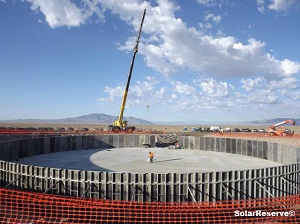SolarReserve gets county approval to move forward with Colorado plans
 Last week, SolarReserve received approval from Saguache County, Colo., allowing it to move forward with its plans to build two 100-megawatt concentrating solar power systems in Colorado’s San Luis Valley. But the company isn’t ready to turn dirt on the projects just yet.
Last week, SolarReserve received approval from Saguache County, Colo., allowing it to move forward with its plans to build two 100-megawatt concentrating solar power systems in Colorado’s San Luis Valley. But the company isn’t ready to turn dirt on the projects just yet.
That follows approval from Xcel Energy and Tri-State Generation to allow one of the projects on their jointly owned transmission lines. The company still has to find transmission line availability for the other 100-MW project, according to SolarReserve Senior Vice President Tom Gorgis.
“The next step for us is getting a PPA,” Gorgis said. Securing such a power-purchase agreement should be a lot easier now that the company received its approval from the county for the projects. “Now that we have a 1041 for the project, it’s much more viable.”
However, Colorado’s utilities say they are close to meeting their requirements under the state’s renewable portfolio standard, which requires they source 30 percent of their electricity from renewable sources by 2020.
Originally Xcel, the state’s largest utility, projected that it would need much more electricity by 2020, but following the recession that started in 2008, Xcel determined that it would need less energy by 2020, reducing the need for more large solar projects.
“The load in Colorado has certainly diminished as it had in many states, because of that contraction in growth. We’re certainly appreciative of that,” Gorgis said.
Still, the company is in talks with utilities in the state and isn’t looking at supplying power to other states, according to Gorgis.
“We’re certainly talking to everyone—all the utilities, Co-ops, munis or Xcel—trying to identify the best fit for the project and the off-taker.”
The company is confident that utilities will find the technology favorable since it has thermal storage and can provide base-load, reliable power.
The technology can also help the grid accept more renewable energy, since it can produce more or less electricity depending on the grid’s needs, according to Gorgis. The company’s efforts may also be boosted by the fact that it now has a very similar plant, the Crescent Dunes project, under construction in Nevada.



